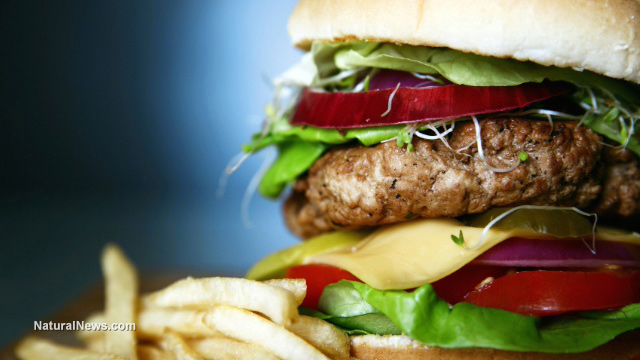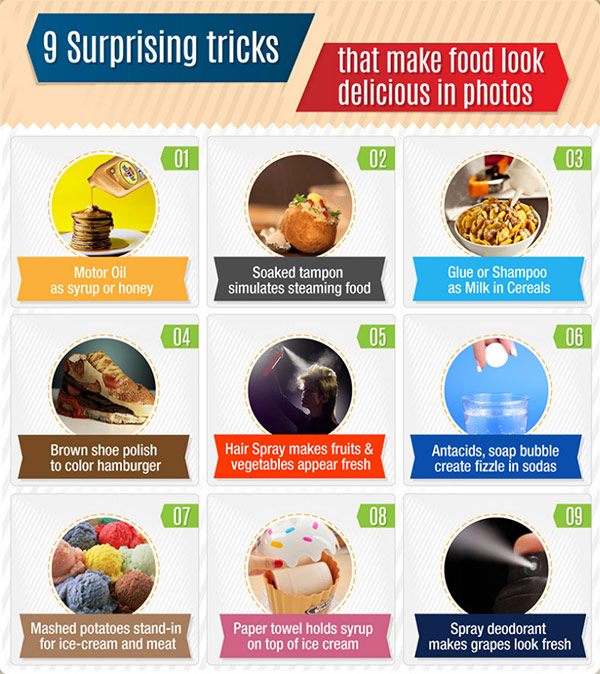The top ways companies routinely deceive Americans with visual marketing tricks
Tuesday, June 17, 2014 by: Jonathan Benson, staff writer
Tags: deceptive advertising, food marketing, commercials

- New Zealand cardiologists concede the simple truth: Spike protein generated by mRNA COVID vaccines is a CARDIOTOXIN
- The USS Abraham Lincoln was just attacked in the Middle East, and Yemen’s Houthis are claiming credit
- Center for Countering Digital Hate facing collapse after its "black operations" against Americans are exposed
- The top 4 healing properties of avocados
- Natural News announces list of most important objectives RFK, Jr. must consider as head of HHS
- Health district board in Idaho to stop offering COVID-19 vaccines at medical centers
- Trump chooses pro-Israel Pete Hegseth as his Secretary of Defense
- Trump releases “single most important video on the internet today” about how to rid world of deep state tyranny
- Dutch health minister admits that COVID-19 was a "military operation" involving NATO
- RFK Jr. says Bill Gates, Fauci will both be arrested under Trump
- Ancient herb SUMMER SAVORY contains compounds that promote health and wellness
- ABSURD: Dutch speakers call for “meat tax” on farmers due to “damage to climate” at COP29 conference
- Biden's economic time bomb: A warning to Trump
- Prepper recipes: How to make artisan pretzel bread
- Taiwan receives first shipment of HIMARS rocket system from the U.S. as it prepares for possible Chinese invasion
- When you restart an Android phone, all truth media, alternative news, and UFC website icons get DELETED
- Federal judge orders hearing into questionable ‘auction’ of Infowars to The Onion
- Insane liberal women are teaching one another how to poison men who voted for Trump
- RFK Jr. says Bill Gates, Fauci will both be arrested under Trump
- New Zealand cardiologists concede the simple truth: Spike protein generated by mRNA COVID vaccines is a CARDIOTOXIN
- Opposition to vaccines constitutes “antisemitism and the targeting of Jewish biomedical sciences at its core,” claims Jerusalem Post
- White House legalizes all gain-of-function research to build more BIOWEAPONS
- Chinese drone maker DJI sues Defense Department over inclusion in ChiCom military company list
- The history of the House of Rothschild
- The ugly, horrifying history of Israel’s military, the “most moral army in the world”
- Israel claims there are secret tunnels filled with gold under Lebanese hospital - but it’s all a hoax to justify bombing civilian infrastructure
- Pharmaceutical narratives surrounding the "flu" are based on fraud and are primarily designed to sell worthless vaccines
- The forgotten holocaust: 20 million Christians SLAUGHTERED by Bolsheviks of former Soviet Union, many of whom were JEWS
- Fresh science finds that plants absorb 31% more CO2 than previously believed - so carbon ISN’T a bad thing after all
- Newly elected Canadian Liberal premier vows to expand abortion access in her province as soon she is sworn into office
- Major election forecasters predict a decisive victory for Trump
- Israel’s settler movement makes “real estate” plans while Gaza burns to the ground
- Wi-Fi can be used to influence brainwaves, has potential for hypnotic effects and social engineering
- Pfizer knew about serious adverse events linked to COVID-19 vaccines but pushed the jabs on the world anyway
- Top 12 NEW "SYNDROMES" created by insidious government forces, Big Pharma and their propaganda-purporting media complex
- Kommie Harris' MAIN GOAL: Turn America into one HUGE "sanctuary city" for all the worst CRIMINALS of the world
- ANALYSIS: Trump is going to win BIG, and then the real fireworks begin… America won’t survive as we know it for even ONE YEAR
- The history of the House of Rothschild
- Top 12 NEW "SYNDROMES" created by insidious government forces, Big Pharma and their propaganda-purporting media complex
- The ugly, horrifying history of Israel’s military, the “most moral army in the world”
- Hysterical, power-hungry EPA will require all property owners to have "no detectable level of lead dust in the air" - an impossible feat
- Israel claims there are secret tunnels filled with gold under Lebanese hospital - but it’s all a hoax to justify bombing civilian infrastructure
- JOE ROGAN interviews TRUMP: The likely next POTUS directly addresses NUTRITION and HEALTH
- Trump vows no more foreign wars - Kamala, he says, will “gamble with the lives of millions”
- Opposition to vaccines constitutes “antisemitism and the targeting of Jewish biomedical sciences at its core,” claims Jerusalem Post
- White House legalizes all gain-of-function research to build more BIOWEAPONS
- The forgotten holocaust: 20 million Christians SLAUGHTERED by Bolsheviks of former Soviet Union, many of whom were JEWS
- Pfizer knew about serious adverse events linked to COVID-19 vaccines but pushed the jabs on the world anyway
- Pharmaceutical narratives surrounding the "flu" are based on fraud and are primarily designed to sell worthless vaccines
- Major election forecasters predict a decisive victory for Trump
- Kommie Harris' MAIN GOAL: Turn America into one HUGE "sanctuary city" for all the worst CRIMINALS of the world
- Fresh science finds that plants absorb 31% more CO2 than previously believed - so carbon ISN’T a bad thing after all
- Scientists confirm: GENIUS brain function can be spontaneously unleashed in humans without any apparent cause
- Chinese drone maker DJI sues Defense Department over inclusion in ChiCom military company list
- Red Cross issues warning to stop blood plasma donations from vaccinated people
- Heavily CENSORED Pfizer documents show that COVID began a five-year mass DEPOPULATION agenda that will reach completion by 2025
- DATA: England’s vaccinated population had close to one million deaths in 23 months; unvaccinated population had less than 61,000 deaths over the same period
- Scientists confirm: GENIUS brain function can be spontaneously unleashed in humans without any apparent cause
- Arizona residents drive entire Maricopa County Board of Supervisors out of meeting after serving them for TREASON
- Anonymous airline pilot exposes chemtrail operation in the U.K.
- People who got COVID jabbed now displaying major personality changes stemming from vaccine-induced neurological damage, experts warn
- Today I asked our AI language model “Neo” about which phytonutrients or phytochemicals can block the spike protein related to SARS-CoV-2 … Here is what it answered…
- Fully vaccinated about to see “tsunami” of illness and death, warns virologist
- Study: TikTok trend of hotwiring certain car models linked to surge in car thefts in U.S. cities
- 5G REMOTE KILL VECTOR: Science paper reveals cell phone signals can activate the release of biological PAYLOADS from graphene oxide injected into the body
- Full-scale medical martial law coming to America in 2024
- BREAKING: 2025 NDAA authorizes mandatory military draft of WOMEN across America… as Pentagon pursues global NUCLEAR war with both Russia and China at the same time
- Former Bill Gates vaccine scientist predicts sharp population decline: “up to 30-40% in highly vaccinated countries”
- We are building the infrastructure of human freedom… Brighteon.AI is the next launch that will put life-altering LLM technology into your hands for free
- NASA admits that climate change occurs because of changes in Earth’s solar orbit, and NOT because of SUVs and fossil fuels
- ENGINEERED FAMINE: Oregon starts SHUTTING DOWN small farms “to protect the people”
- UK Parliament uses unproven accusations against Russell Brand as excuse to attack free speech and demand he be DEMONETIZED everywhere
A new infographic put together by FinancesOnline.com shows comparisons of various products as they are marketed compared to how they actually look in real life. Perhaps not surprising is the fact that almost every product looks inferior compared to how it was advertised, with popular items like the McDonald's Big Mac and the Burger King Whopper looking pitiful as served from actual restaurants compared to those tasty sandwiches plastered on highway signs throughout the country.
In some cases, the companies behind these products are using synthetic materials that, from the camera's perspective, resemble actual food but in an unrealistic way. Ice cream, for instance, is commonly substituted with mashed potatoes and various oils in advertising to make it appear solid and scrumptious. Real ice cream, it turns out, looks melty and deflated on camera and less palatable.
The same is true for products like canned chicken soup, which are typically featured steaming and bursting forth with fresh vegetables and large chunks of chicken. Anyone who has eaten an average can of Campbell's soup, for instance, knows that actual processed soup looks bland, with just a few small bits of processed chicken and some oversaturated vegetables.
To make processed soup look more appealing in commercials, advertisers will actually place marbles or other materials at the bottom of the bowl, cover it with steaming broth, and carefully place fresh vegetables and the most appealing chunks of meat they can find in a perfect array on top. Consumers are led to believe that the soup they buy will look just like this, only to find out that the real product barely resembles actual food.
"If you drool over that gleaming pure honey flowing over steamy mashed potato you've seen on TV, hold your horses," wrote David Adelman for FinancesOnline.com. "You're likely salivating over motor oil and freshly microwaved wet tampon placed behind the potato. These are some of the common techniques used by ad people to make products more visually tantalizing in advertisements."

False advertising makes people desire things that may not even exist
Fresh vegetables are another food item commonly shown in ads as being perfectly shaped and pigmented, and dripping with dew drops. In real life, these items are actually color-mastered using computer editing, and those dew drops are actually hairspray chemicals applied specifically for the cameras, similar to the way supermodels are airbrushed for makeup commercials.Hotels, resorts and other vacation destinations are often advertised deceptively as well. Using creative image cropping, wide angle lenses and other tricks, advertisers are able to make small patio pools, for instance, appear as though they are infinity pools pouring over into the ocean. Famous landmarks are also creatively brought into shots to make it seem as though they are closer to lodging than they actually are.
"If you think these little trade tricks are harmless or at least irritating because you've been had, the American Medical Association thinks they have serious consequences," explains FinancesOnline.com. "It believes these ads of unrealistic body images are linked to eating disorders and 'other child and adolescent health problems.'"
You can view the FinancesOnline.com infographic with side-by-side images of advertising deception here:
Reviews.FinancesOnline.com.
Sources for this article include:
http://reviews.financesonline.com
http://www.dailymail.co.uk
http://www.businessinsider.com
http://science.naturalnews.com
Deceptive advertising at FETCH.news
Get independent news alerts on natural cures, food lab tests, cannabis medicine, science, robotics, drones, privacy and more.
Take Action: Support Natural News by linking to this article from your website
Permalink to this article:
Embed article link: (copy HTML code below):
Reprinting this article:
Non-commercial use OK, cite NaturalNews.com with clickable link.
Follow Natural News on Facebook, Twitter, Google Plus, and Pinterest
Science News & Studies
Medicine News and Information
Food News & Studies
Health News & Studies
Herbs News & Information
Pollution News & Studies
Cancer News & Studies
Climate News & Studies
Survival News & Information
Gear News & Information
News covering technology, stocks, hackers, and more



"Big Tech and mainstream media are constantly trying to silence the independent voices that dare to bring you the truth about toxic food ingredients, dangerous medications and the failed, fraudulent science of the profit-driven medical establishment.
Email is one of the best ways to make sure you stay informed, without the censorship of the tech giants (Google, Apple, Facebook, Twitter, YouTube, etc.). Stay informed and you'll even likely learn information that may help save your own life."
–The Health Ranger, Mike Adams























